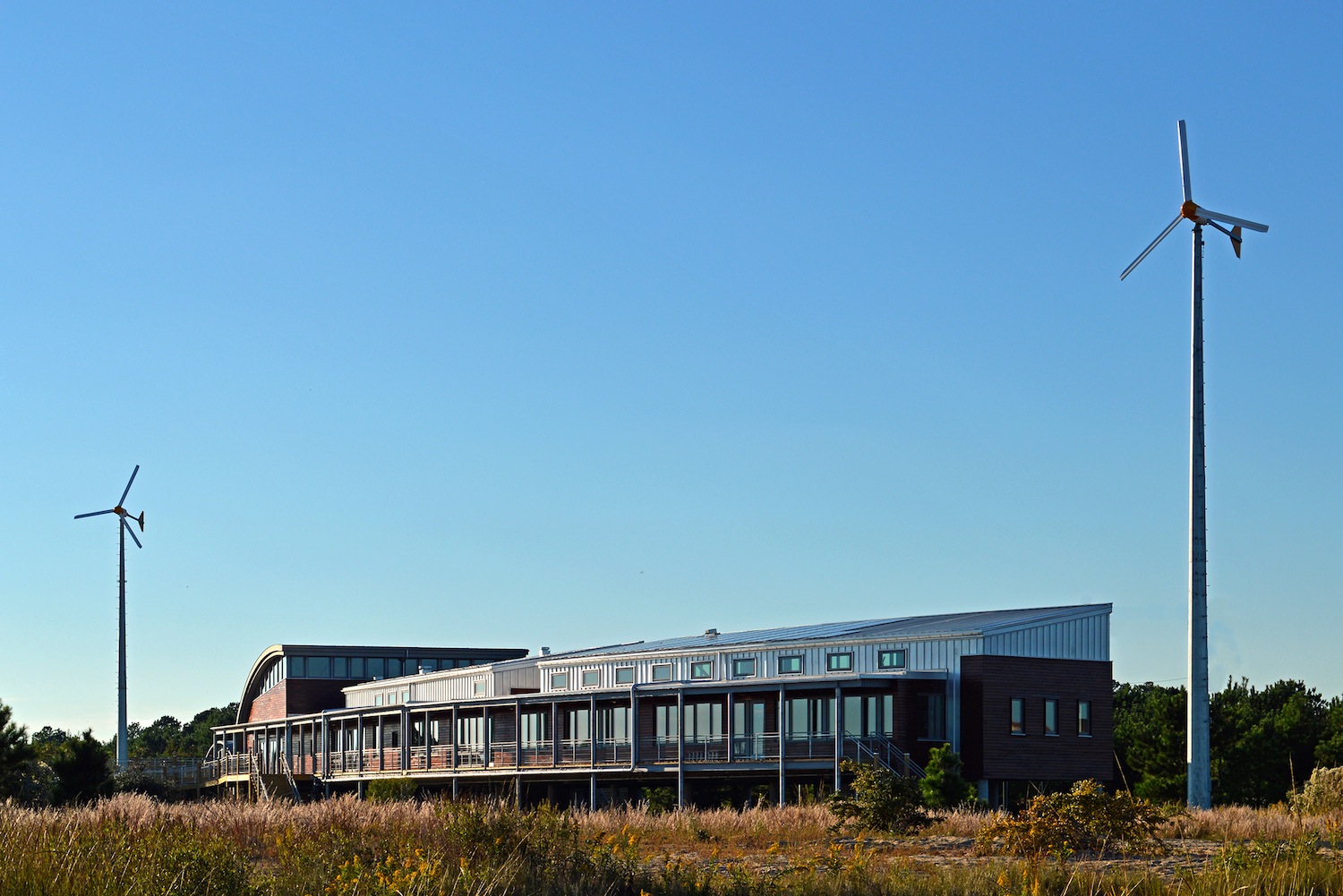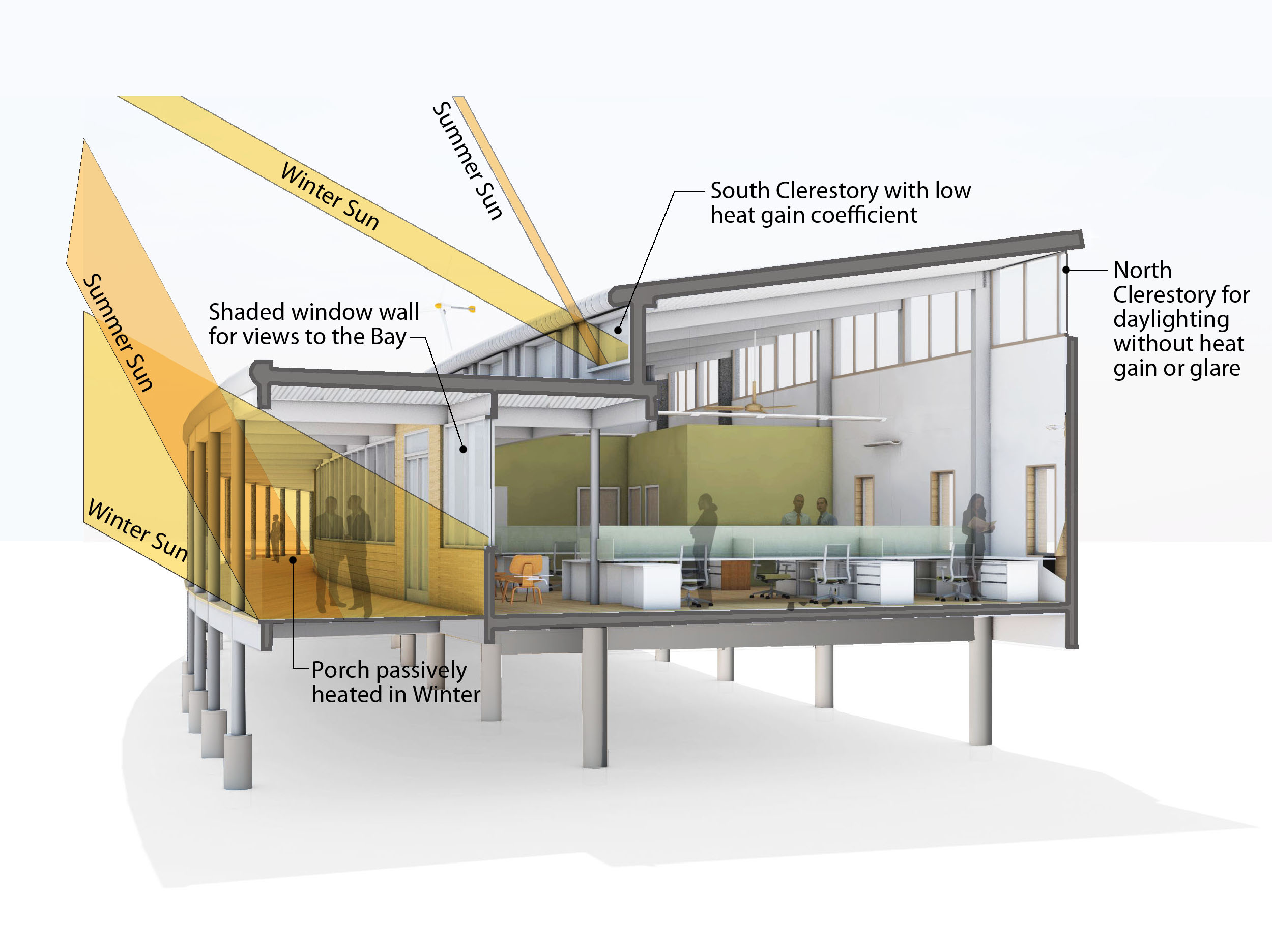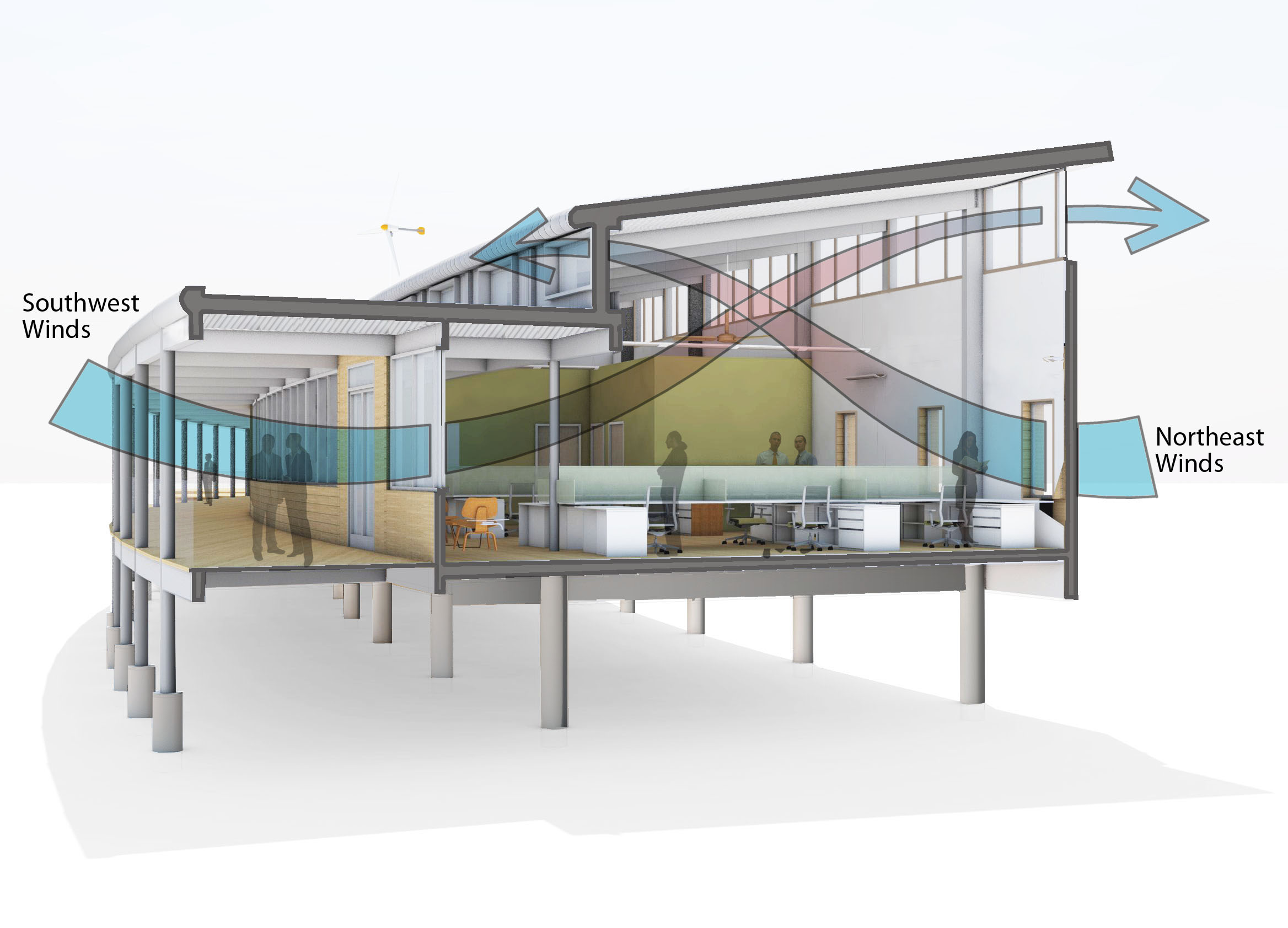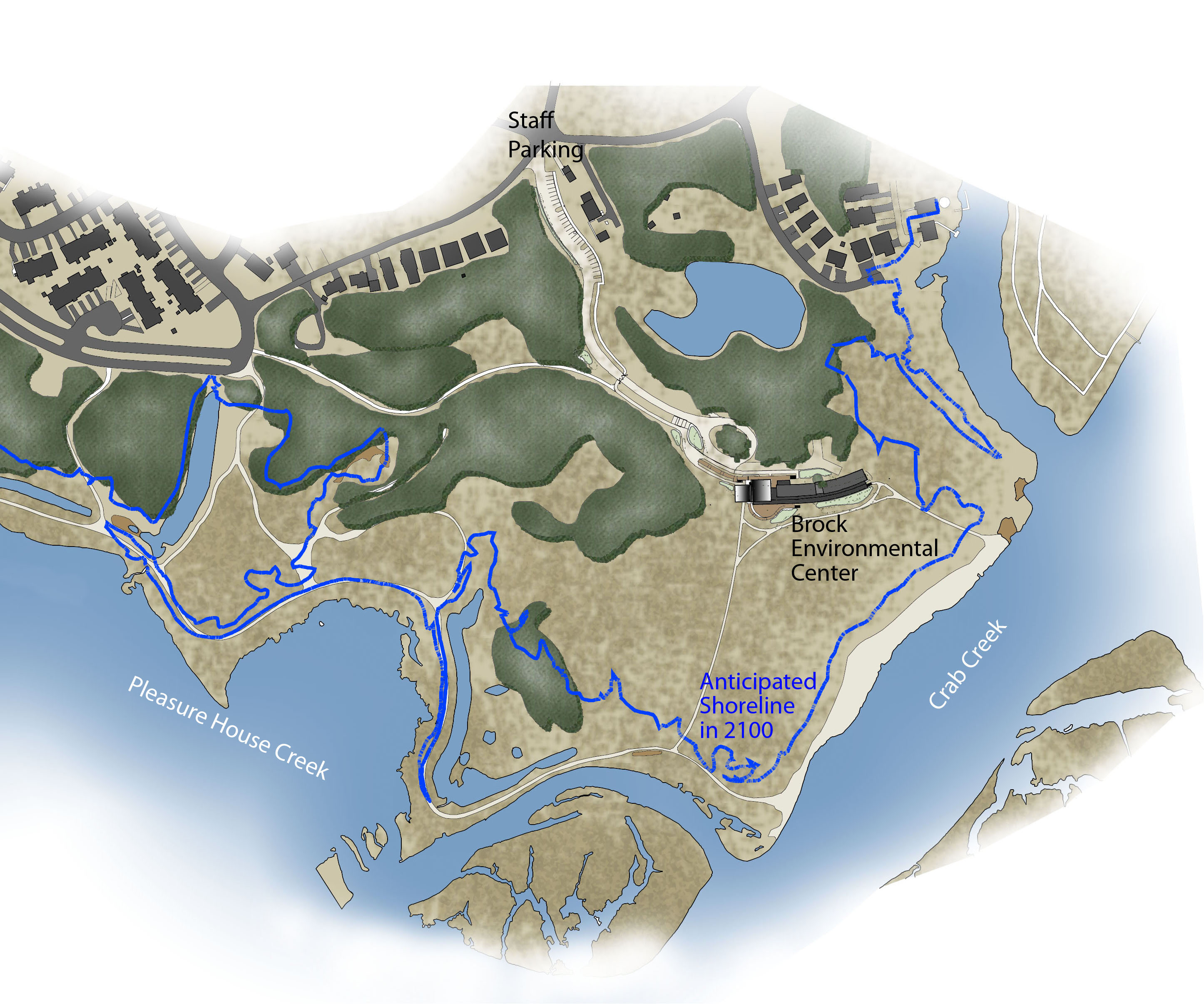The Chesapeake Bay Foundation’s (CBF) Brock Environmental Center reached construction completion today in Virginia Beach, Va. Designed by SmithGroupJJR and constructed by Hourigan Construction, the Center is an international model for energy and water efficiency and climate change resiliency.
The 10,000-sf, one-story building will serve as the hub for CBF’s Hampton Road office and support its Chesapeake Bay education, outreach, advocacy and restoration initiatives. In addition to offices for CBF and partner groups, the Center provides meeting rooms and exhibit display areas, and an 80-seat conference room designed to express CBF’s mission to defend one of the nation’s most valuable and threatened natural resources—the Chesapeake Bay.
Every aspect of the Center—location, materials, utilities, operation and use—meets the strictest environmental standards. “With the Brock Environmental Center, CBF is raising the bar for sustainability,” said Greg Mella, FAIA, LEED AP, SmithGroupJJR project manager and design architect.
“The Brock Center is a model for environmental awareness in our industry,” commented Mark Hourigan, president of Hourigan Construction.
The Center is targeting LEED Platinum designation and also strives to meet the strict standards of the Living Building Challenge (LBC), a green building certification program promulgated by the International Living Future Institute that defines the most advanced measure of sustainability in the built environment possible today. LBC standards require the facility to have “net zero” impact on the environment. The Brock Environmental Center would become the first building in Virginia to earn LBC certification; to-date, only five projects in the world have achieved Full Certification through the Living Building Challenge.
Designed for Resiliency on a Preserved Site
Completion of the Center concludes a successful community effort to save Virginia Beach’s 118-acre Pleasure House Point tract from development. As recently as 2008, developers intended to build more than 1,100 new high-rise condos and townhouses on the property. The collapse of the housing market in 2009, however, led to bank foreclosure of the property.
A community partnership with CBF, the City of Virginia Beach and the Trust for Public Land purchased the land from the bank in 2012, preserving it for open space and environmental education. The new Center, the only major structure on the entire 118 acres, takes up only one-half acre of CBF’s 10-acre parcel. Preserving the local ecology was paramount upon development of the site, which includes a boat pier with floating dock and an open-air education pavilion.
The project is situated on a coastal site to facilitate the client’s outdoor education program. The design anticipated the onset of sea-level rise and hurricanes: the building is set back 200 feet from the shore and sits on pylons 14 feet above sea level. Even the building’s structural steel system was designed to be capable of resisting 120-mph hurricane force winds.
“We had the opportunity to push the envelope on innovative and creative methods,” said Chris Brandt, executive vice president of Hourigan Construction. “There were so many certification levels that needed to be met that it was a job in itself to keep track of them all.”
Targeting Net-Zero Water, Energy and Waste
SmithGroupJJR designed the building to use very little energy by incorporating a series of aggressive, energy-saving features such as natural ventilation, natural daylighting and sunshading, highly efficient geo-thermal heating and cooling, and super insulation.
The Center is on track to be the first commercial-scale building in the continental U.S. to earn net-zero water status. A rainwater collection system will store rainwater in tanks under the building and then filter it for hand-washing and drinking through a state-of-the-art water filtration system licensed by the State of Virginia’s Office of Drinking Water. The Center features waterless, composting toilets, and all grey water (wastewater generated from sinks and showers) will be channeled through a wetland constructed of native plants where natural processes will clean and return it to the underground aquifer.
Net-zero energy status will be realized as the building generates its own electricity via solar and wind-powered renewable energy. The Center’s array of 38.8 kW rooftop photovoltaic panels will produce 60 percent of the building’s energy needs by converting the sun’s energy to electricity. Two small, 10-kilowatt wind turbines, 80’ tall, will contribute the remaining 40 percent of the building’s energy needs. Using only as much energy as it generates over the course of a year will enable the Center to earn net-zero energy certification. Surplus energy will be returned to the power grid.
Materials: Natural and Salvaged, “Red List” Chemicals Avoided
For the Center, construction materials were selected for their natural and simple properties. Preference was given to materials that are bio-based instead of those heavily processed, complex, synthetic and chemical-based. In specifying building materials, the design and construction team took special care to not use any materials on the International Living Future Institute’s “Red List,” which identifies chemicals and materials considered harmful to humans and the environment.
As a LBC requirement, recycled, salvaged and reclaimed materials were used extensively throughout the project. Examples include cypress siding from reclaimed sinker logs, wood flooring made from old fence posts and barn siding, interior wood trim from salvaged high school bleachers, and mirrors and toilet accessories from a local hospital demolition. The Rainwater Cistern and reception desk millwork were constructed from salvaged pickle barrels, and cabinet hardware consists of used champagne corks.
Hourigan Construction used cutting-edge building techniques in constructing the Center in order to minimize environmental impacts. In addition to using toxin-free building materials, sustainable measures used during construction included solar-powered tools and paperless construction documents. Normal construction equipment noise was reduced by the use of filters and baffles on the exhaust systems of all operating equipment, and slings or, in effect, construction equipment diapers were used so no equipment discharge would be deposited on the building site.
Even Hourigan’s on-site construction offices used less energy and water than normal systems. Instead of piping in treated water from the public grid, a deep fresh water well was installed to utilize existing water for construction use.
CBF: Continuing to Push the Boundaries of Sustainability
The Chesapeake Bay Foundation will occupy the building by the end of 2014. Prior, building occupants will be trained in the day-to-day operations and measurements of the renewable technologies. A 12-month measurement period is planned to commence in early 2015 and continue until early 2016. LBC certification is targeted for mid-2016.
The ultra-green Brock Environmental Center is the latest CBF initiative to push the boundaries of sustainability. The Foundation started with the 2000 completion of its Annapolis, Maryland headquarters building, the Philip Merrill Environmental Center, also designed by SmithGroupJJR. In 2001, the Merrill Center became the world’s first LEED Platinum building and was soon-after recognized as an international model of sustainability.
“What LEED Platinum was when we were designing the Philip Merrill Environmental Center, the Living Building Challenge is now,” said SmithGroupJJR’s Mella, who is based at the firm’s Washington, DC office. “Back then, we were designing to do less harm to the environment. Now, we’ve designed a building that could actually improve the environment,” he added.
The Brock Environmental Center is named in honor of Virginia Beach philanthropists Joan and Macon Brock in recognition of their $3.5 million donation toward the $21 million capital campaign to build, operate and endow a new Hampton Roads environmental center.
Joining SmithGroupJJR (architect and MEP engineer) and Hourigan Construction (general contractor) were WPL Site Design, Virginia Beach, civil engineer and landscape architect; and A+F Engineers, Washington, DC, for structural engineering. Skanska, New York, NY, served as the owner’s representative.
SmithGroupJJR (www.smithgroupjjr.com) is a recognized, integrated design firm with 800 employees in 10 offices. With more than 100 LEED certified projects and 343 LEED professionals, SmithGroupJJR is a national leader in sustainable design.
Hourigan Construction (www.houriganconstruction.com) is a full-service construction management company with operations throughout the Southeast U.S. The firm has constructed multiple projects in the Hampton Roads region and across Virginia.
Related Stories
| Aug 11, 2010
F&S Partners merges with SmithGroup
F&S Partners, a Dallas architecture firm specializing in the design of educational, recreational, and religious projects, has merged with SmithGroup, a top 10 U.S. architecture/engineering firm. The 40-person office in Dallas will carry the name SmithGroup/F&S.
| Aug 11, 2010
Will Alsop to head up new RMJM studio
Will Alsop, the internationally acclaimed British architect and designer of the Glenwood Waterfront project on the Hudson River, is to turn his attention once again to the U.S. after announcing he is to create a studio called “Will Alsop at RMJM,” as part of the RMJM worldwide architectural firm.
| Aug 11, 2010
AECOM, WATG top BD+C's ranking of the nation's 75 largest hotel design firms
A ranking of the Top 75 Hotel Design Firms based on Building Design+Construction's 2009 Giants 300 survey. For more Giants 300 rankings, visit http://www.BDCnetwork.com/Giants
| Aug 11, 2010
Parsons Brinckerhoff, Dewberry among nation's largest multifamily design firms, according to BD+C's Giants 300 report
A ranking of the Top 75 Multifamily Design Firms based on Building Design+Construction's 2009 Giants 300 survey. For more Giants 300 rankings, visit /giants
| Aug 11, 2010
USGBC’s Greenbuild 2009 brings global ideas to local main streets
Save the planet with indigenous knowledge. Make permanent water part of your life. Dive deep water for clues to environmental success. Connect site selection to successful creative concepting. Explore the unknown with Discovery Channel’s best known guide. These are but a few of the big ideas participants can connect to at USGBC’s Greenbuild International Conference and Expo, taking place on November 11-13, 2009 in Phoenix, Ariz.
| Aug 11, 2010
Goettsch Partners wins design competition for Soochow Securities HQ in China
Goettsch Partners (GP) has been selected as the winning firm in the competition to design the Soochow Securities Headquarters, the new office and stock exchange building for Soochow Securities Co. Ltd. The 21-story, 441,300-square-foot project includes 344,400 square feet of office space, an 86,100-square-foot stock exchange, meeting rooms, classrooms, a cafeteria, and underground parking for 400 cars and 800 bicycles.
| Aug 11, 2010
RMJM unveils design details for $1B green development in Turkey
International architecture company RMJM today announced details of the $1 billion Varyap Meridian development it is designing in Istanbul’s new residential and business district, which will be one of the "greenest" projects in Turkey. The luxury 372,000-square-meter development on a site totalling 107,000 square meters will be located in the Atasehir district of Istanbul, which the Turkish government intends to transform into the country’s new financial district and business center.
| Aug 11, 2010
Urban Land Institute honors five 'outstanding' developments in Europe, Middle East, and Africa
Five outstanding developments have been selected as winners of the Urban Land Institute (ULI) 2009 Awards for Excellence: Europe, Middle East, and Africa (EMEA) competition. This year, the competition also included the announcement of two special award winners. The Awards for Excellence competition is widely regarded as the land use industry’s most prestigious recognition program.










